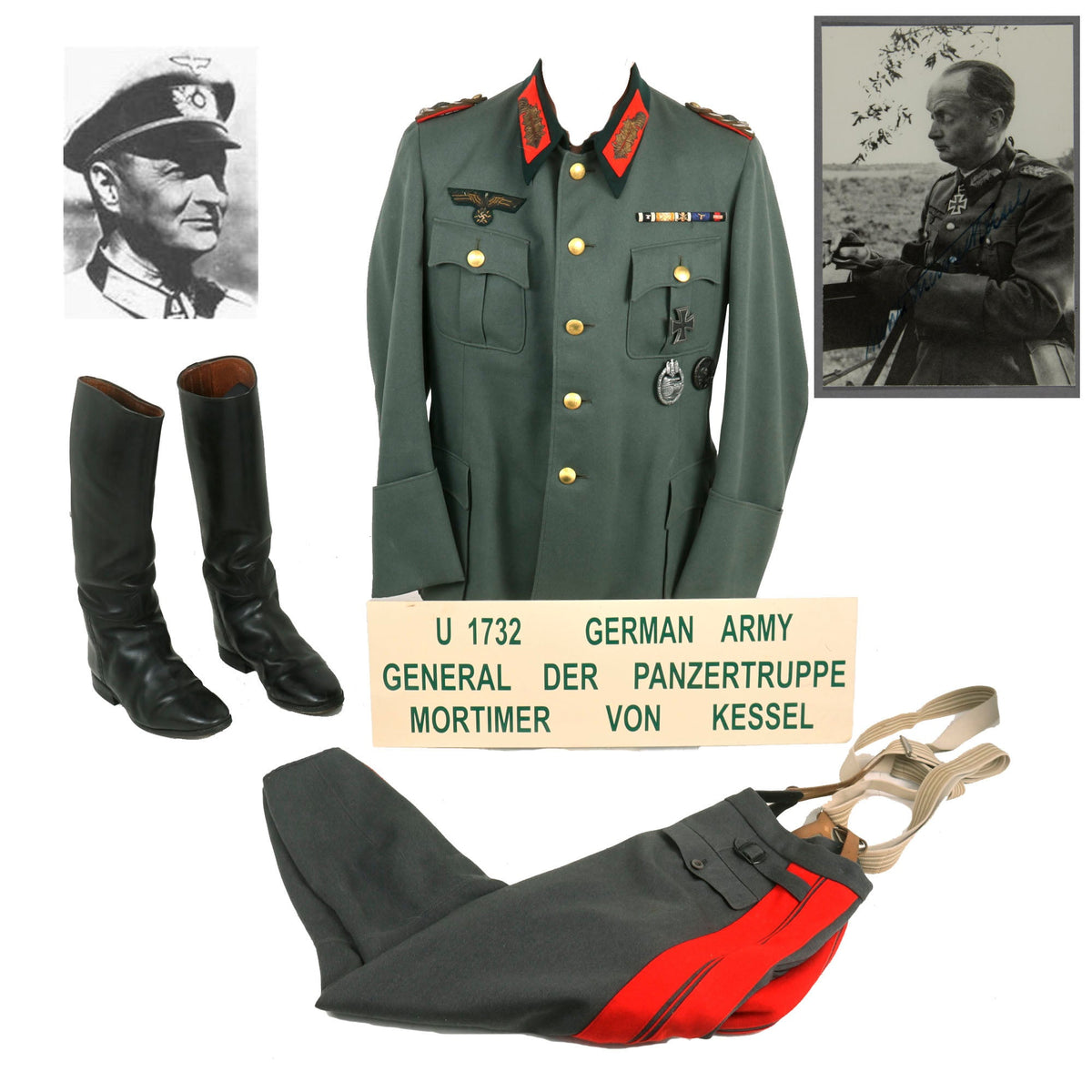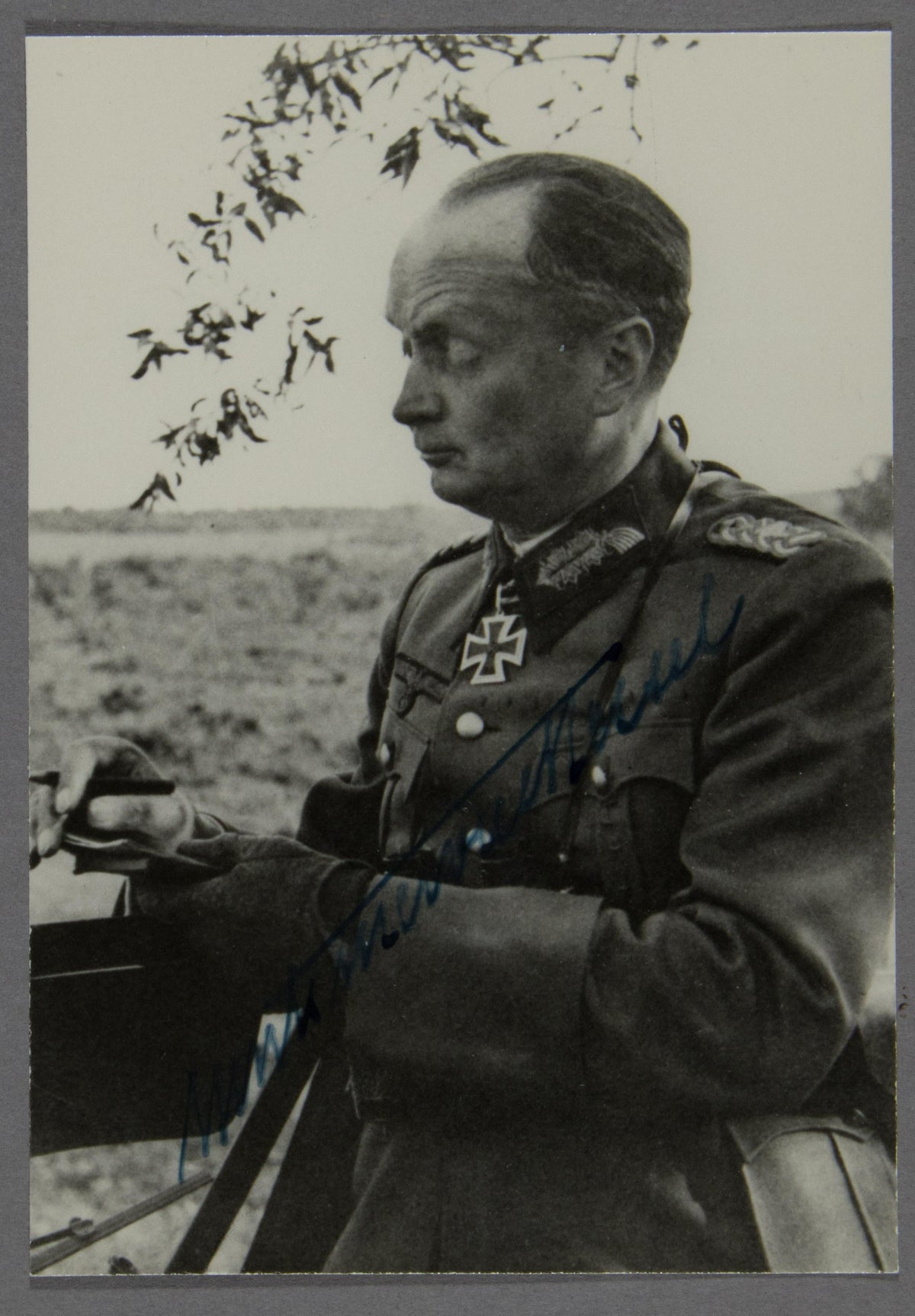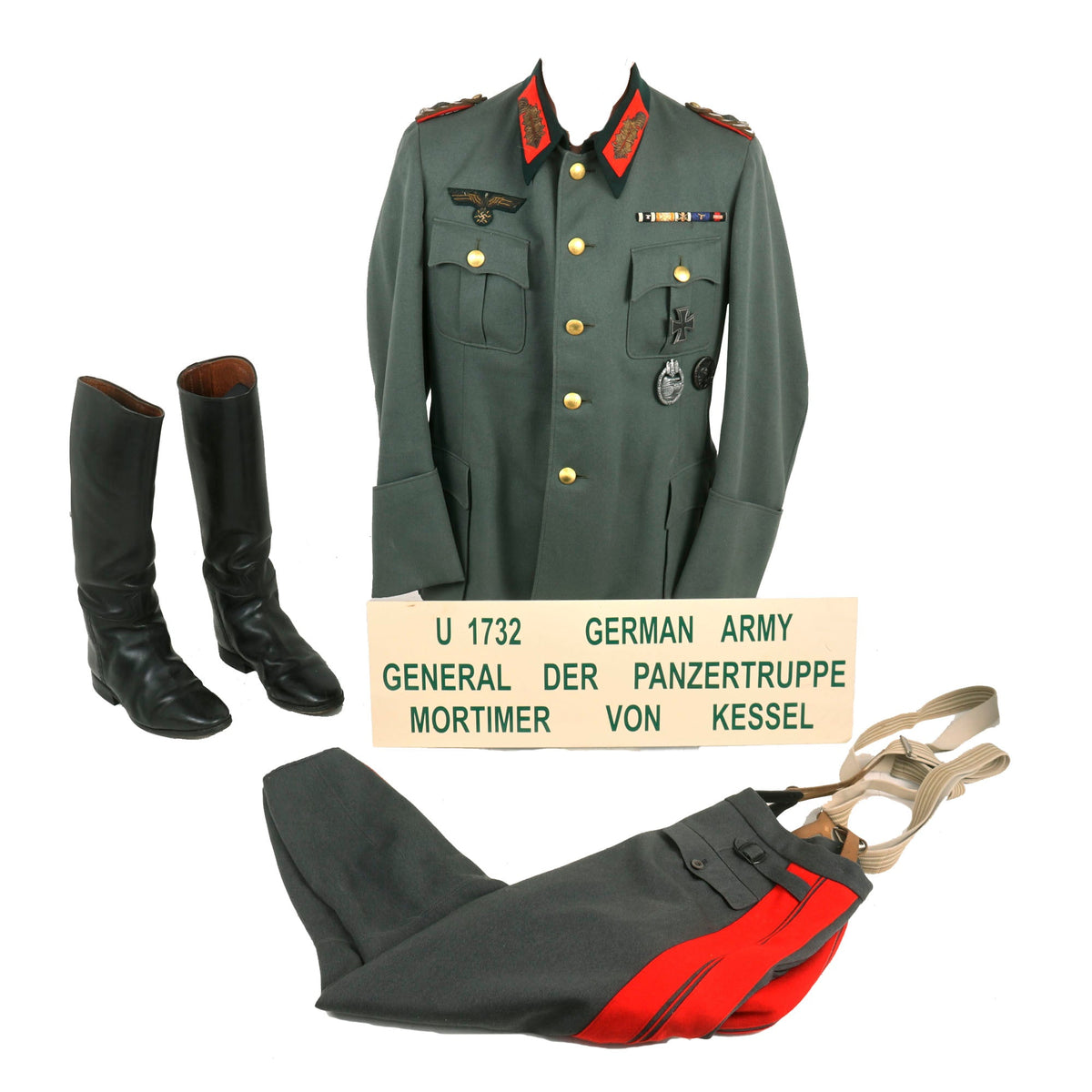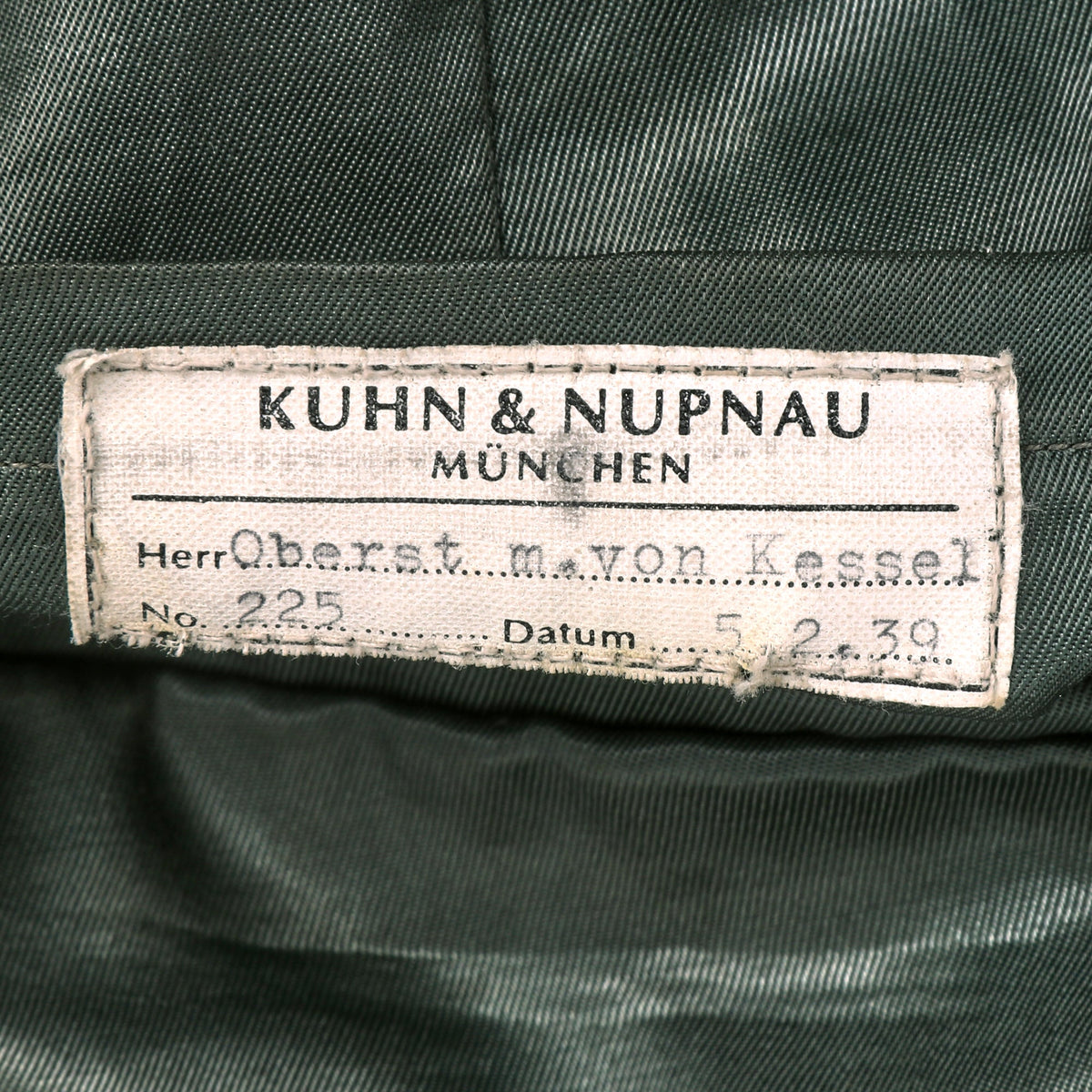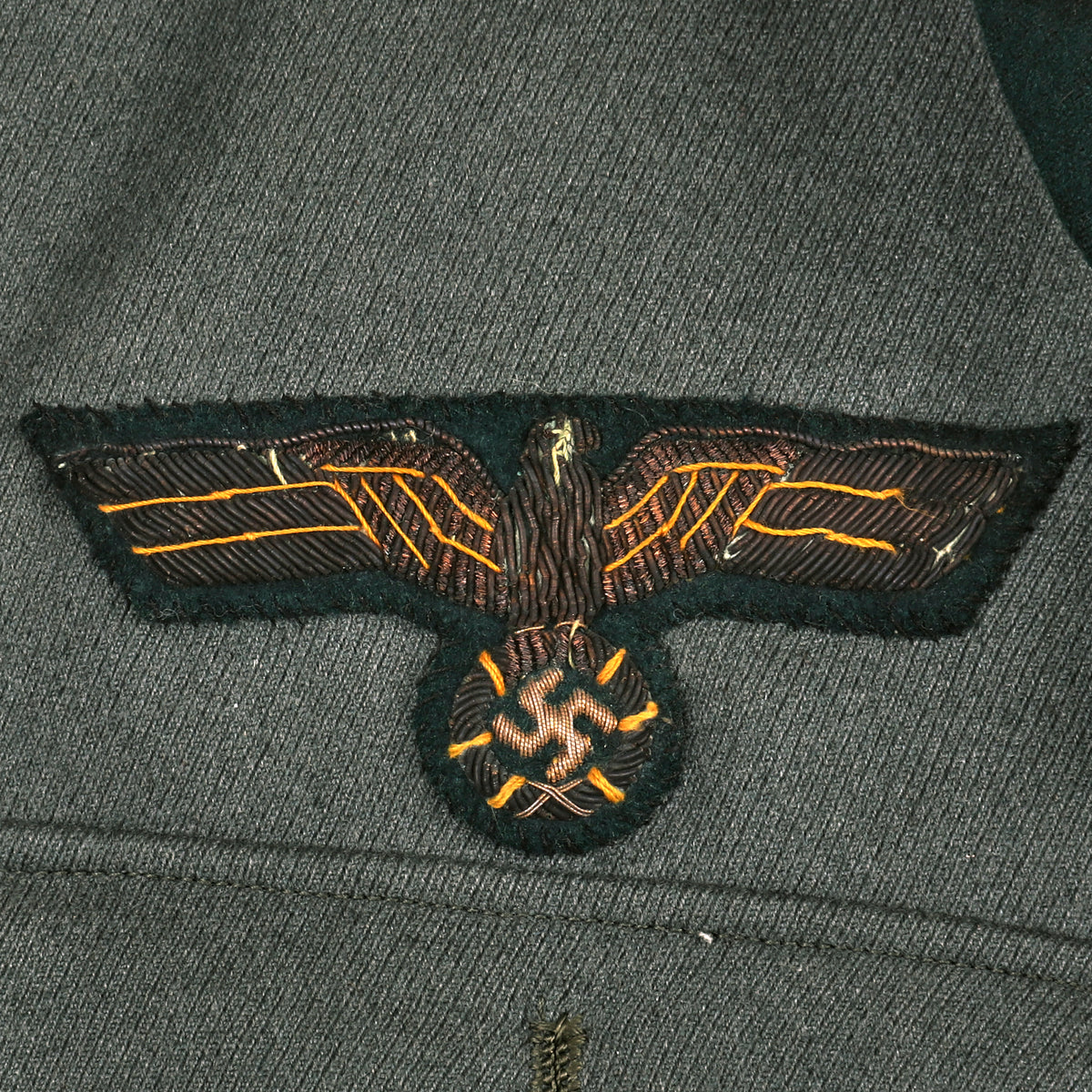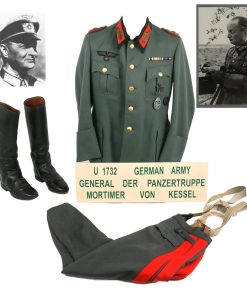Original German WWII 20th Panzer Division and VII Panzerkorps Commander General der Panzertruppen Mortimer von Kessel Uniform Set – Formerly Part of the A.A.F. Tank Museum Original Items
$ 11.995,00 $ 2.998,75
Original Items: One-of-a-kind set. Mortimer von Kessel (25 May 1893 – 8 January 1981) was a German Panzertruppe General in the Heer Army during World War II, who commanded the 20th Panzer Division and later the VII Panzer Corps during his WWII service. Originally an Oberst (Colonel) at the beginning of the war, he eventually rose to the rank of General der Panzertruppe (Lt. General) at the end of the war when commander of the VII Panzerkorps. He was a recipient of the Knight’s Cross of the Iron Cross, later receiving Oak Leaves for it, as well as many other prestigious awards.
This wonderful German WWII Named Uniform Set came to us from the American Armoured Foundation, Inc. Tank and Ordnance Memorial Museum. The AAF Tank Museum was a living memorial dedicated to the Tank and Cavalry soldiers of the world. Before 1981 some of the artifacts that make up the AAF Tank Museum was a private collection belonging to Mr. William Gasser. Mr. Gasser felt that his collection would be beneficial in educating present and future generations to the sacrifices made and the technologies gained during war. Therefore, in 1981 the AAF Tank Museum was established as a non-profit charitable organization, and Mr. Gasser’s donated his private collection to the Tank Museum. Mr. Gasser is still active as Volunteer Director and Curator of the Tank Museum and his knowledge of military history has been a great asset to the museum. Unfortunately after 20 years of operation it had to close its doors, which is when this set was acquired.
Born 25 May 1893, Mortimer von Kessel joined the Imperial German Army in August 1914 as an officer cadet, being commissioned as a Leutnant on 22 March 1915. He was a part of the Thüringisches Husaren-Regiment Nr. 12 (12th (Thuringian) Hussar Regiment) during WWI, and received several awards during his service. He would later continue his military service as a member of the Reichswehr under the Weimar republic. He was a career soldier, and continued his service after the NSDAP takeover of Germany. He was well-decorated, and the following is a list of awards we have been able to locate, along with the dates they were bestowed, if available:
● Iron Cross (1914)
– 2nd Class (27 March 1915)
– 1st Class (25 September 1917)
● Knight’s Cross of the Second Class of the Order of the White Falcon with Swords
● Cross of Honor for Frontline Fighters
● Iron Cross (1939)
– 2nd Class (spange)
– 1st Class (spange)
Most notably, he was awarded the Knight’s Cross of the Iron Cross on 28 December 1943 as Generalmajor and commander of the 20. Panzer-Division for actions for his actions in the Vitebsk region on the Eastern Front. He was then the 611th Recipient of the Oak Leaves for the Knight’s Cross on 16 October 1944 as Generalleutnant of the same division. It should also be noted that due to his long service he would have qualified for the Wehrmacht Long Service awards, and other awards not listed. Many of these are represented in the medal bar his uniform bears, which also looks to have some awards not mentioned on listings that we have. There is also a very nice Iron Cross First class 1939, Panzer Assault Badge, and Black Wound badge attached to the uniform under the left pocket.
The lovely M36 uniform tunic in this set was made for Kessel in February of 1939, when he was an Oberstleutnant or Oberst (records are not entirely clear), prior to the invasion of Poland where he led a Reconnaissance regiment. It is a lovely bespoke example, still bearing the maker tag at the back of the collar for Kuhn & Nupnau, München, which also still has a clear maker label inside the left inner pocket, which reads:
KUHN & NUPNAU
MÜNCHEN
——————-
Herr Oberst m. von Kessel
Nr. 225 ….. Datum 5. 2. 39
This indicates that when Kessel was promoted to Generalmajor during 1942, he had the staff officer insignia removed, and replaced with the correct General grade collar tabs, eagle, and shoulder boards. When he was later promoted to Generalleutnant in December 1943 and General der Panzertruppen in March 1945, all that he needed to do was apply rank “pips” to the shoulderboards. It is however possible that they were entirely replaced as well.
The tunic is really a great example of a private purchased Wehrmacht Heer Dienstbluse (Service Tunic), originally made for a Stabsoffiziere (Staff Officer) but upgraded to be for a Generäle (General Officer). It is constructed from a fine quality field-gray “whipcord” wool woven exterior, with a silk-rayon blended green interior lining. The sleeves are lined with the usual blue / gray striped rayon. The collar is constructed of flaschengrün(dark bottle-green) wool, and is adorned by a set of General grade collar tabs, known as alt-Larisch or Arabesque style, which were used for all General ranks below Feldmarschall. These have the correct red backgrounds with gold bullion embroidery, which has oxidized over the years.
The tunic conforms well to the M36 pattern, having 4 pleated pockets on the front with scalloped flaps. All of the pebbled buttons are the correct gold color for a General officer, and all look to be maker marked on the back.
Each shoulder is decorated with the sew-on style General der Panzertruppen rank shoulder boards. They are both constructed out of a row of interwoven silver and gold bullion strands in the typical Russian braid style in an interlocking weave pattern ending at a pebbled gilt metal (magnetic) button. There are two rank pips installed, correct for a General der Panzertruppen and other specialized General ranks equivalent to a U.S. Army Lt. General. Of note is that they are different materials and sizes, with the outer pair being smaller and silvered, while the inner pair is larger and oxidized. We do not know which pair were added first, but that they are matching pairs means they were almost certainly added during wartime.
On the right breast is a fine quality gold bullion eagle, constructed of rolled, twisted, and flat hand embroidered gilt stitching with celeon retaining threads, placed onto a dark bottle green wool backing. It is neatly stitched to the outer layer of fabric, however the bullion has oxidized quite a bit, now displaying a dark oxidized patina, while the celeon threads are still bright yellow.
Along with the tunic there is a lovely pair of General’s breeches / jodhpurs in the correct stone gray (steingrau) color, with red stripes on the side, which comes with the correct suspenders. They are in very good shape, and definitely period correct, though they do not have any markings on the inside.
Finishing out the set is a lovely set of German WWII officer’s tall jackboots, which are in very good condition, and look to be a matched pair! They are both marked with 48 38 on the inner top interior side, with 20124 1 9 on the outer sides, just above the pull loops.
Along with the uniform are some great additional items that really flesh out this fantastic set, and add lots of wonderful research and display potential. These include:
● The original painted metal display placard used when the uniform was owned and displayed by the A.A.F. Tank Museum.
● The original information / inventory listing from the A.A.F. Tank Museum, which gives a very detailed history of von Kessel’s military progression during the interwar years and during the war.
● Some printed out or photocopied research material in a small folder, including a grainy photograph of Kessel. All of this is in German.
We were also able to find just TWO photographs of Kessel on the internet, one of which is an autographed photograph. These are shown for illustrative purposes only and are not included.
We very seldom get uniform sets with such great provenance and research potential. This could become the centerpiece of your WWII collection. Ready to research and display!
Approximate Measurements:
Collar to shoulder: 9.5″
Shoulder to sleeve: 25”
Shoulder to shoulder: 16”
Chest width: 21″
Waist width: 20″
Hip width: 23″
Front length: 31″
Pants:
Waist: 16.5″
Inseam: 26.5″
More Military Service Information on Mortimer von Kessel:
Mortimer von Kessel (25 May 1893 – 8 January 1981) was a Panzer General in the German army during the Second World War. He originally joined the Imperial German Army as an officer cadet in 1914 and was commissioned as a Leutnant in the 12th Hussar Regiment on 22 March 1915 and was awarded the Iron Cross first and second class in the First World War.
He was then retained in the Reichswehr in which he reached the rank of Oberstleutnant by 1937. He led a reconnaissance regiment during the Invasion of Poland in 1939 and was promoted to Oberst during or prior to October of that year. During the following month he was appointed as the head of the Army Personnel Department and remained in this post until January 1943, having been promoted to Generalmajor in 1942. Kessel was then moved to the leadership reserve until 8 May 1943, when he was appointed as the commander of the 20th Panzer Division. On 1 December 1943, he was promoted to Generalleutnant, and for his defense of the Vitebsk region on the Eastern Front he was awarded the Knight’s Cross of the Iron Cross. Then for his actions during the Soviet Summer Offensive of 1944 he was awarded the Oak Leaves to the Knight’s Cross of the Iron Cross. In December 1944, he was appointed commander of the VII Panzer Corps in East Prussia. On 1 March 1945, he was promoted to General der Panzertruppe and continued to command the panzer corps until he was captured.
More on German Uniform Tunics
Terms such as M40 and M43 were never designated by the Wehrmacht, but are names given to the different versions of the Model 1936 field tunic by modern collectors, to discern between variations, as the M36 was steadily simplified and tweaked due to production time problems and combat experience.
Field Tunic (Feldbluse) Model 1936
When the NSDAP came to power in early 1933 the Reichswehr, the armed forces of the Weimar Republic, were near the end of a two-year project to redesign the Army Feldbluse (field-blouse). Beginning in that year the new tunic was issued to the Reichsheer and then the rapidly growing Wehrmacht Heer, although minor design changes continued to be made until the appearance of the standardized Heeres Dienstanzug Modell 1936. The M36 tunic still retained the traditional Imperial and Reichswehr uniform color of grey-green “field gray” (feldgrau) wool, but incorporated four front patch pockets with scalloped flaps and pleats (on Reichswehr tunics the lower pockets were internal and angled). The front was closed with five buttons rather than the previous eight, and the collar and shoulder straps were of a dark bottle-green instead of the Reichswehr grey. Compared to the Weimar-era uniforms the skirt of the feldbluse was shorter and the tailoring was more form-fitting due to Germany’s adoption of mechanized warfare: soldiers now spent much time in the confined space of a vehicle and a shorter jacket was less likely to pick up dirt from the seats. It also included an internal suspension system, whereby a soldier could hang an equipment belt on a series of hooks outside of the tunic. These hooks were connected to two straps inside the lining, which spread the weight of equipment without having to use external equipment suspenders. The M36 was produced and issued until the very end of the war, though successive patterns became predominant.
Fast Shipping with Professional Packaging
Thanks to our longstanding association with UPS FedEx DHL, and other major international carriers, we are able to provide a range of shipping options. Our warehouse staff is expertly trained and will wrap your products according to our exact and precise specifications. Prior to shipping, your goods will be thoroughly examined and securely secured. We ship to thousands clients each day across multiple countries. This shows how we're dedicated to be the largest retailer on the internet. Warehouses and distribution centres can be located throughout Europe as well as the USA.
Note: Orders with more than one item will be assigned a processing date depending on the item.
Before shipping before shipping, we'll conduct a thorough inspection of the items you have ordered. Today, the majority of orders will be delivered within 48 hours. The delivery time will be between 3-7 days.
Returns
The stock is dynamic and we cannot completely manage it because multiple stakeholders are involved, including our factory and warehouse. So the actual stock may alter at any time. It's possible that you may not receive your order once the order has been made.
Our policy is valid for a period of 30 days. If you don't receive the product within 30 days, we are not able to issue a refund or an exchange.
You can only return an item if it is unused and in the same state as the day you received it. You must have the item in its original packaging.
Related products
Uncategorized
Uncategorized
Uncategorized
Uncategorized
Uncategorized
Uncategorized
Uncategorized
Uncategorized
Uncategorized
Uncategorized
Uncategorized
Uncategorized
Uncategorized
Uncategorized
Uncategorized
Uncategorized
Uncategorized
Uncategorized
Uncategorized
